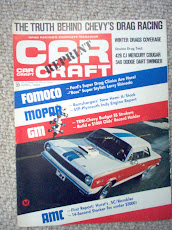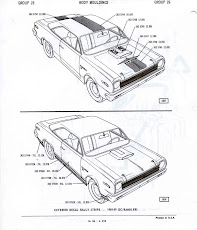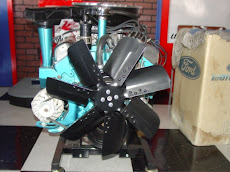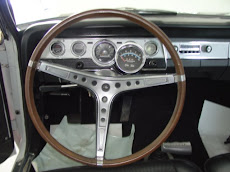Anything related to maintenance , tune up specs etc.
Brakes: Booster & M/C , Etc:
Article by Jim McKee ,
There are also two versions of the single diaphram power disc brake booster that fits SC/Ramblers. The biggest rebuilder of power brake boosters is Cardone.
I have gotten single diaphram boosters that just won't haul a SC/Rambler down as it did when new. SC/Ramblers in 1969 stopped 16 feet quicker than a Jaguar from 70 mph. If you bought one of the weaker Cardone single diaphram boosters they have, at least in my case, replaced it with the stronger one, which works like the original.
SC/Rambler booster's have a straight in screw in check valve at 10 o'clock looking at the booster with the master cylinder pointing at you. Cardone doesn't have any SC/Rambler booster cores and you have to send yours in to get a rebuilt one. This means you will get yours back when rebuilt. New correct straight in check valves are available from Kennedy American for $ 10.00 .
The brake line pressure limiter on disc brake cars, that is back on the passenger's side frame rail near the flexible hose to the rear axle is an IMPORTANT piece of the brake system on disc brake cars. If you convert front drums to disc you need this piece.
I had replaced a SC/Rambler power brake booster on a customer's car with a Cardone unit and the car just did not stop very well. After going through every other brake component on the vehicle, I complained to the vendor I bought the rebuilt booster from. He called Cardone and told me the guy he talked to could add 100 pounds of boost to the unit I had. When it was returned to me and installed it functioned just like the original booster and the vehicle stopped like a SC/Rambler should. I don't know what the "boost" setting or "rating" was of the booster I initally got, but the second one with the plus 100 pounds boost worked quite well. I have no idea how to tell what boost a particular power brake booster is.
I am having similar problems with the Kelsey Hayes pressure limiter valve on the passenger frame rail by the flexible hose to the rear axle. I know there were 200 and 400 pound limiter valves, because they have different AMC part numbers. You are supposed to be able to tell them apart by a blue paint daub on the 200 pound valves, that were used on SC/Ramblers and on disc brake AMXs, Javelins and Americans. The 400 pound valve has a black paint daub. The paint daub would be a wonderful way to tell them apart if they weren't all almost 40 years old by now and the paint is long gone! I have an extensive collection of these things and have tried to find someone to decode the numbers stamped into the body of these things, with NO success.
K-H is Kelsey-Hayes the now defunct manufacturer. The company that bought K-H is still making these things, but they don't know if they are 200 or 400 pound units and didn't realize there were originally two different ratings. They only thing they know is they fit 68 big block Camaros. There are also three digits followed by a "-" and then a single 8 or a 9. I am guessing this is the year they were manufactured. I don't have a guess as to what the three numbers signify. Just another obscure AMC circular reference!
As to suggestions on installing the linkage, booster, and master cylinder, I put the booster on the linkage section and leave the hardware loose. Push the master cylinder brake lines down out of the way. I position the linkage on the firewall studs again with loose hardware, push the booster towards the middle of the car and finesse the master cylinder in and then tighten eyerything up. Ratchet wrenches are a help. You already know how tight a fit all these parts are.
Transmission Pops out of gear :
Article written by Jim McKee
These are the items that cause an AMC T-10 in SC/Ramblers to not remain in gear besides the shifter handle hitting the seat in second and fourth. The seat interference problem is easily corrected by bending the shift handle at the bend about an inch at the T-handle. I know most SC/Rambler owners don’t want to bend and re-chrome their shift handles, so check these other items first;
Shifter adjustment. If the synchro sleeve is not moved completely into mesh with the synchro teeth on the gear it will often pop out. Readjust the shifter using a 1/4" drill or dowel pushed in the hole that runs through the shifter body and levers. Replacing the original nylon lever bushings with Hurst steel bushings tightens up the shifter.
A bent shifter fork can prevent the sleeve from fully engaging the teeth on the gear. The result is similar to an out of adjustment shifter. Replace the bent shifter fork. Please note; 1st and 2nd fork is the same as the 3rd and 4th fork.
The levers that bolt to the side of the transmission are loose and the effect is the same as bad shifter adjustment or bent fork. Tighten the levers. Usually requires readjusting the shifter.
The "C" shaped springs inside the synchro assembly that press on the three rectangular slider retention pieces inside the synchro sleeve are weak and this allows the sleeve to contact the teeth on the gear before the two are turning the same speed preventing them from fully engaging. Replace the entire synchro sleeve assembly. Individual parts are not available for synchro assemblies other than the brass synchro rings. The brass rings are available from Mr. Gasket in a four pack for Chevrolet T-10s. AMC T-10 small parts kits, shifter forks, front and rear seals, main shaft bearings, yoke bushings, bearings, first and reverse gear, and gasket kits are still available. Notice I did not include input shafts, reverse idler, third, or second gear, or the counter shaft. Many parts books list the same bearing for the input and mainshaft. The correct input shaft bearing has bearing shields and these metal rings cover the balls and prevent oil from flooding the front seal and leaking. The rear mainshaft bearing should not have these shields.
If the teeth on the gear or inside the synchro sleeve are worn and rounded off, they will be forced out of engagement (pop out of gear). They should look like a house with the roof peak pointing toward the synchro sleeve. If they are rounded off or broken the trans will not stay in gear. The teeth inside the sleeve need to be pointed the same shape as those on the gear but facing the gear. Please refer to the available parts listing in the previous paragraph. Speed shifting your SC/Rambler with the accelerator on the floor is not a good idea, because of the AMC T-10s limited gear availability.
The clutch is not properly releasing the disc. Readjust the clutch free play. If the free play adjustment is used up or makes no difference the clutch is probably worn out. The clutch can be rusted to the input shaft and this holds the disc in contact with the flywheel or pressure plate. Either of these items can prevent the synchro sleeve from fully engaging the gear increasing the likelyhood of coming out of gear. Replace the clutch. I suggest using a Hays street/strip diaphragm unit for Chevrolets 10 1/2" diameter disc with 1 1/8"x 10 spline #40-111, the pressure plate #33-610. For this clutch to work properly, the throw out bearing collar needs to be shortened by .200" where the throw out bearing presses on and the bell crank to fork lever must be lengthened to allow correct adjustment range. The big benefit with this clutch is it releases the disc much faster than the original Borg and beck clutch with rpm assist rollers and the transmission shifts are greatly improved. This clutch is rated for 500 horsepower and 7000 rpm.
The transmission is not in line with the crankshaft. This usually affects 4th gear only.
If the roller bearings inside 4th gear that ride on the mainshaft in front of 3rd gear synchro assembly are worn this can promote the trans coming out of 4th or 3rd gear. If the ball bearing on the mainshaft is galled the vibration can allow the trans to come out of gear. Usually 1st or 2nd. If the needle bearings in the countershaft are galled at the rear of the shaft this usually affects either 1st or 2nd or both. If the needle bearings are galled at the front of the shaft this usually affects 3rd or 4th or both.
Anonymous said...
VALVE STEM SEALS : Seems like the seals need to be replaced on all the original low mile engines ?
Personaly , after that many years , even low miles . Would think it would be time to put aFull gasket and seal kit in ...The gaskets fall apart after so many years .
Friday, April 25, 2008
MAINTAINING YOUR SC/R
Posted by
SC/RAMBLER1969
Subscribe to:
Post Comments (Atom)









No comments:
Post a Comment